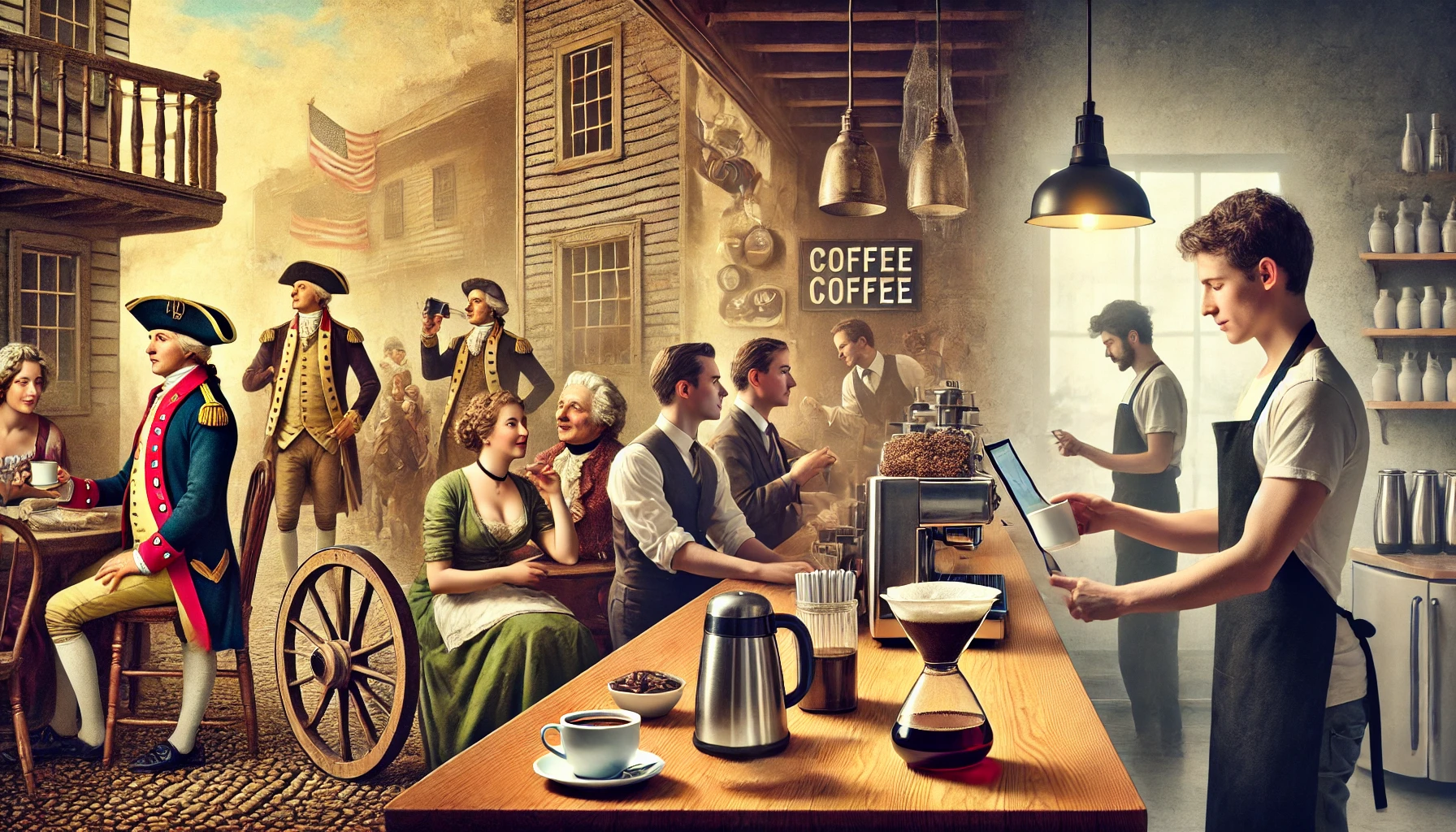The United States is one of the largest coffee-consuming nations in the world, but its journey with coffee has evolved dramatically over time—from mass-produced instant brews to today’s sophisticated specialty scene. America’s coffee story is one of reinvention, innovation, and a deepening appreciation for what goes into each cup.
In this article, we’ll explore how coffee became a cultural force in the U.S., from the Revolutionary War to the rise of café culture and the modern third wave movement that continues to reshape how Americans drink and think about coffee.
Colonial Beginnings: Tea Out, Coffee In
Coffee first arrived in the American colonies in the 17th century through European trade. However, it didn’t immediately dominate. Tea was the preferred drink—until the Boston Tea Party in 1773, when American revolutionaries, protesting British taxes, dumped tea into the Boston Harbor.
This event had a surprising cultural consequence: drinking coffee became a patriotic act. Americans began switching from tea to coffee, cementing it as a symbol of independence and resistance.
From that point on, coffee steadily became part of daily American life.
Civil War and Instant Coffee
During the Civil War (1861–1865), coffee was a crucial part of a soldier’s rations. Union troops received green coffee beans, which they roasted and brewed in the field. Some soldiers became so reliant on coffee that it was even used in bartering.
To simplify preparation, the U.S. Army also experimented with instant coffee—a precursor to what would become a major trend in the 20th century.
The war years helped embed coffee into American identity as a fuel for hard work, resilience, and survival.
The Rise of the Diner and Drip Coffee
In the early 20th century, coffee became synonymous with the American diner—a democratic space where anyone could get a hot meal and a bottomless cup of coffee.
This era popularized the drip brew method, using percolators and later automatic drip machines. Brands like Maxwell House and Folgers dominated the market, offering convenience and affordability.
Coffee became a ritual of the working class, present in lunch counters, office buildings, and homes nationwide.
World War II and Coffee Rationing
During World War II, coffee was rationed, and many Americans were introduced to instant coffee on a large scale. The U.S. military provided brands like Nescafé and Maxwell House to soldiers overseas.
Though less flavorful, instant coffee offered a quick, caffeine-packed solution. Its convenience would later drive the post-war boom in commercial coffee consumption, especially during the suburbanization of the 1950s and ’60s.
The Coffee Break Becomes a Right
In 1952, the Pan-American Coffee Bureau launched an advertising campaign promoting the concept of the “coffee break” as a necessary pause in the workday. The idea caught on so quickly that by the 1960s, coffee breaks were included in many union contracts.
Coffee became part of workplace culture, symbolizing both productivity and camaraderie.
The First Wave: Mass Production and Marketing
The first major “wave” of American coffee culture was defined by mass production, convenience, and branding. This period was dominated by:
- Canned ground coffee
- Large-scale advertising
- Supermarket availability
Coffee was seen less as a culinary product and more as a daily necessity—a functional part of morning routines.
The Second Wave: The Rise of Specialty and Starbucks
The second wave of American coffee began in the 1970s and ’80s, marked by a growing appreciation for coffee quality, origin, and preparation.
This shift was spearheaded by companies like:
- Peet’s Coffee & Tea (founded in 1966 in Berkeley, California)
- Starbucks (founded in 1971 in Seattle)
Starbucks, in particular, revolutionized the market by turning coffee into a lifestyle experience. Espresso-based drinks like lattes, cappuccinos, and mochas became mainstream. Cafés became “third places”—spaces between home and work for relaxation and connection.
Coffee suddenly had flavor, status, and cultural value.
The Third Wave: Coffee as Craft
The early 2000s saw the emergence of the third wave coffee movement, which treats coffee as an artisanal product, much like wine or craft beer.
Third wave cafés focus on:
- Single-origin beans
- Direct trade with farmers
- Precise brewing methods (pour-over, siphon, Chemex, etc.)
- Transparency and sustainability
Pioneering roasters and cafés include:
- Blue Bottle Coffee
- Intelligentsia
- Stumptown
- Counter Culture Coffee
These companies elevated the coffee conversation to include ethics, ecology, and flavor complexity. Baristas became highly trained professionals, and latte art became a form of expression.
Tech and Coffee: The Silicon Valley Influence
The intersection of technology and coffee is uniquely American. In cities like San Francisco and Portland, tech startups and coffee roasters grew side by side.
Apps like Ritual and CUPS allowed consumers to pre-order from indie cafés. Data-driven roasting profiles, smart home brewers, and even blockchain coffee traceability platforms emerged—making coffee not only delicious but high-tech.
Coffee and Identity in Modern America
Today, coffee in the U.S. is highly personal and diverse. Consumers can choose:
- Organic cold brew from a local co-op
- Pumpkin spice latte from a national chain
- Nitro brew from a tap
- Classic drip from a diner
Coffee represents more than caffeine—it reflects one’s values, lifestyle, and community.
From TikTok trends to subscription boxes, from oat milk to mushroom coffee, the U.S. remains at the forefront of innovation in how people consume and talk about coffee.
Final Thoughts: From Commodity to Culture
The American coffee revolution is a story of transformation. What began as a colonial alternative to tea has become a symbol of creativity, resilience, and identity.
Coffee is now more than a drink—it’s a ritual, a profession, a cultural anchor, and a booming industry. And as the U.S. continues to shape global coffee trends, it carries with it a legacy of reinvention—and a future full of bold brews and even bolder ideas.

